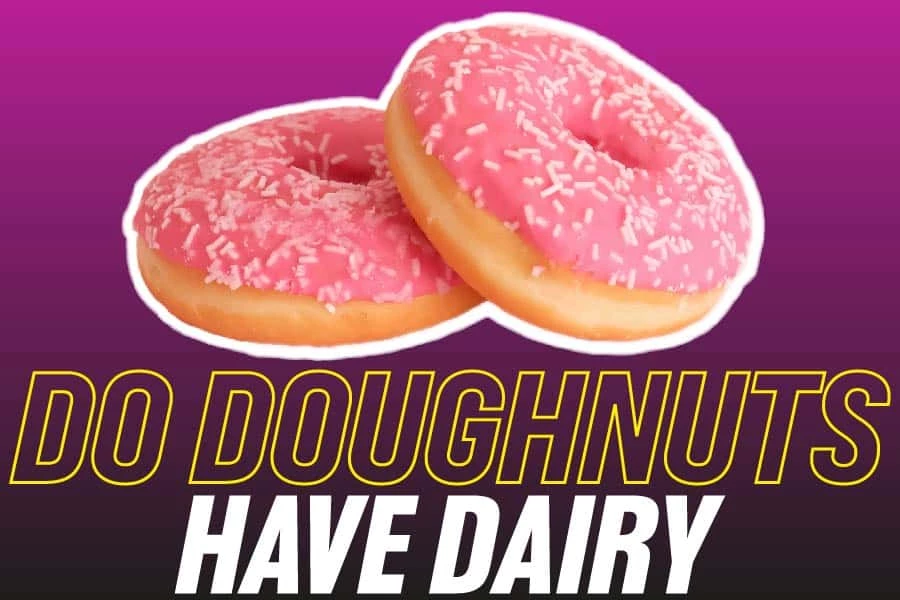Over 10 million doughnuts are made in the United States every year. But then, it’s not a surprise learning that doughnuts are a popular snack. Even though they don’t have much nutritional value, they’re still a yummy snack. And the variety of toppings and fillings makes doughnuts even more desirable.
It’s okay to know the ingredients in your favorite snack. It’s also helpful if you have an allergy or dietary concerns, so you can avoid consuming snacks that can mess up your health. That’s what this article aims to actualize.
Now, let’s face the question.
Do Doughnuts Have Dairy?
Yes, doughnuts boast dairy. The popular doughnut options are the regular or traditional ones and part of their signature ingredients is dairy. However, there are options without dairy. They are primarily for vegetarian, vegan, or lactose-intolerant people.
Any doughnut you buy from a bakery or shop contains dairy unless it mentions otherwise.
Do Doughnuts Have Vegan Options?
Yes, there are vegan doughnut options. But the regular and popular ones that everybody knows are not vegan. The regular ones are in most shops and doughnut stands. Unless the sellers label them as “suitable for vegetarians or vegans,” they’re most likely not.
The three animal products in regular doughnuts include milk, eggs, and butter. And that makes it unacceptable for a vegan lifestyle. It’s also unsuitable for a person that’s lactose intolerant.
Don’t worry if you’re vegan. Thanks to food preparation advancements, there’s a vegan substitute for almost anything. So, even though you have to avoid the regular doughnuts, you can still eat vegan ones. You need to replace the three animal products in the recipe!
How To Replace Dairy In Doughnuts
Replacing dairy is one step in making doughnuts completely vegan. It’s also essential for lactose-intolerant people.
Dairy is a vital ingredient when making batter for your regular doughnut. That’s because it aids in softening the texture of the batter and adds moisture. The good thing is that it’s easy to get a vegan substitute for dairy.
Milk and butter make up dairy components in a doughnut. Here is a great vegan substitute for them.
- Soy milk
- Wheat milk
- Rice milk
- Coconut milk
- Almond milk
- Organic vegan butter
- Flora margarine
- Flora plant butter
How To Replace Other Doughnut Ingredients For Vegan Ones
As we pointed out before, dairy is not the only animal product in a doughnut. Others include eggs and toppings. Let’s look at the other doughnut ingredients you can replace for a vegan option.
Eggs:
Here’s one of the critical ingredients for a regular doughnut. It’s so because eggs give an aerated texture to the batter. They also help the batter stick together. And that’s crucial for a perfect end-product.
However, vegan substitutes will do an egg’s work in the regular dough. They include vegan egg replacers, tofu, baking soda, mashed banana, soy yogurt, and nut butter. And that’s a lot of options!
Fillings:
There are various fillings for doughnuts, with lots of possibilities for what you can use. The most notable ones are jam and custard.
Jam is vegan except for the ones that contain gelatin. But most times custard isn’t, so you’ll have to look for a substitute. An example is vegan custard containing no eggs, milk, or cream.
Other fillings are apples, chocolates, cream, etc. The thing is, they can be vegan if they contain no animal products like dairy. So check with the baker to ensure the ingredients they use if you’re buying from a bakery.
You can also check under the allergens for eggs, milk, and milk-derived products. That’s usually part of the ingredients list and can be helpful clues to animal products.
Toppings:
Doughnuts are versatile when it comes to toppings. You can find just about anything. Some have sugar dusted on them. But you may have to look out for refined sugar. Sometimes animal bone char is used when processing them. It serves to remove impurities and color.
Although animal bone char is not in the sugar, they are part of the production process. So, you can consider substitutes like beet, turbinado, or raw sugar. You can use the alternative for the dough, fillings, or other toppings.
For basic options, you can find icing as a topping. And that’s mostly water and sugar, which makes it vegan-friendly. However, some icing contains butter or gelatin. So, ensure you check the ingredients. You can also ask the manufacturer before using the icing.
If you prefer chocolate toppings on your doughnut, you have to look for milk chocolate. Since it’s not okay for vegans, ensure you stick with dark chocolate. It’s more suitable for a vegan snack but ask questions to be sure.
Avoid cream or custard in your doughnut toppings. It’d be wise to check the ingredients before buying a doughnut with topping.
How To Make Doughnuts Without Dairy
It’s best to make your doughnuts at home. You won’t have to go through the stress of wondering what ingredients they contain. You can also use your favorite vegan ingredients. And the best part is you get to choose your toppings and fillings.
Please note that you have to start early to give your dough lots of time to rise.
Here are the steps for making non-dairy and vegan doughnuts.
Prepare the dough:
You have to start by preparing the dough. First, warm the non-dairy milk in a bowl. Ensure it isn’t too hot; you don’t want to kill your yeast. Then add some sugar and yeast. Whisk the mixture in and leave it for about 10 minutes.
The mixture should get bubbly after that time. If not, the yeast is dead, and you’ll need to start the process again.
Next, soften your vegan butter to room temperature. Then use an electric mixer to beat it with sugar. Then add a little salt and some vanilla. Now, add the previous mixture (milk-yeast) and mix it.
Add in some flour, a little at a time. Use your mixer to beat the mixture as you do so. Soon you’ll notice the mixture is too thick for your mixer. At that stage, switch to a spoon.
After you mix the dough, you’ll have to knead it. To do so, ensure you sprinkle a little flour on the counter. And then knead the dough for about 5 minutes till it gets stretchy and smooth.
Let the dough rise:
The next thing to do after you’ve prepared the dough is to let it increase. Place the dough in a bowl. Ensure you coat the bowl with oil before you do so. You don’t want the dough to stick on it.
Next, place the bowl of dough somewhere warm in your kitchen. You can use your oven, leaving the light on to create a slightly hot environment. Then leave it for about an hour or more, depending on the area’s temperature. The dough will become about twice its original size.
Roll and cut the doughnuts:
After the dough rises, you’ll roll and cut the doughnuts from it. First, sprinkle flour on the surface you want to use or your counter. Next, roll out the dough with a rolling pin; about half an inch thickness will do.
Use a knife or doughnut cutter to cut the flattened dough into doughnuts. Cut them to be about 3 ½ in diameter.
Let the doughnuts rise:
The next thing you want to do is allow the doughnuts to increase. Line some parchment papers on a baking sheet. Then, place the doughnuts on it. After that, cover them using a damp towel. And then, place the sheet on a warm area to allow the doughnuts to rise.
Leave the doughnuts for about 45 minutes to one hour. That’ll give them time to rise properly. You’ll notice when it puffs up slightly.
Fry them:
Now, it’s time to fry your doughnuts. Pour lots of oil into a big pot. Make sure it’s not less than 1 ½ inches deep. Then heat the oil. It’s best to use a deep-frying thermometer to keep track of the heat. You can start frying once it gets to about 350 degrees Fahrenheit.
Put the doughnuts into the hot oil. They’ll float to the surface as you fry them. Ensure you don’t crowd them. Please fry them one side at a time. Make sure one side becomes golden brown before turning to the other. It may take a minute or two for each side.
Line a plate with a paper towel. And then transfer the doughnuts into it as you fry them.
Be careful while frying doughnuts. The oil can be super hurt and cause burns if not handled well. Ensure the doughnuts aren’t left unattended to avoid getting burnt.
Finish the doughnuts:
Once you’re through with frying, you can choose to finish the doughnuts. But allow them to cool down before you do so. Then mix your favorite topping. You may choose to glaze or frost them.
If you’re using glaze, dip both sides of the doughnuts into it. It’ll be all over them.
You can allow the glaze to harden and then dip the top parts of the doughnuts in frosting. You can also add sprinkles depending on your taste.
Now, your vegan or non-dairy doughnut is ready!
It’s important to note that homemade doughnuts a best eaten the day you make them or a day after.
Conclusion
Regular or traditional doughnuts have dairy in them. However, some alternatives can meet your dairy-free or vegan needs. If you’re not sure of the ingredients used in shops near you, you can make it yourself.
It is very important to steer clear if you’re allergic to dairy products or have other concerns. Eat right to live right.
 Being Human
Being Human





